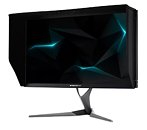Tuesday, April 10th 2018
4K Ultra HD Monitors with 144 Hz Refresh-rate and G-SYNC HDR Start Being Available
As we reported in March, the first 4K monitors with 144 Hz refresh-rate began showing up in stores. This summer, PC gamers and enthusiasts up for a monitor upgrade, are in for a treat. An increasing number of companies are preparing to launch monitors with not just 4K Ultra HD resolution (3840 x 2160 pixels), but also staggering 144 Hz refresh-rates, and support for adaptive sync technologies, such as AMD FreeSync and NVIDIA G-Sync. To push 4K at 144 Hz, you'll need your graphics card to feature DisplayPort 1.4 (or above) connectivity, as DisplayPort 1.2, or even the newer HDMI 2.0, lack the required bandwidth.
Among the first blazing fast 4K UHD + 144 Hz monitors, are the 2018 Acer Predator X27 (UM.HX0EE.009) first unveiled in 2017, and soon to be joined by the ASUS ROG Swift PG27UQ. Both monitors feature 4K Ultra HD resolution, 144 Hz refresh-rate, IPS quantum-dot panels, and support for the new NVIDIA G-SYNC HDR standard. The monitors take input from DisplayPort 1.4 and HDMI 2.0, although you will need DisplayPort 1.4 to get 4K @ 144 Hz to work correctly. The IPS quantum-dot panels feature DCI-P3 color-standards, 99% Adobe RGB coverage, and 10 bpc (1.07 billion-color) palette, in addition to 384 LED elements backlighting the panel. The ROG Swift PG27UQ starts at 2,445€ and the Predator X27 at 18,475 DKK Sounds good? Get ready to foot upwards of USD $3,000 for either of them, to go with your $3,000 TITAN V, for a 3,000-inch e-p.
Among the first blazing fast 4K UHD + 144 Hz monitors, are the 2018 Acer Predator X27 (UM.HX0EE.009) first unveiled in 2017, and soon to be joined by the ASUS ROG Swift PG27UQ. Both monitors feature 4K Ultra HD resolution, 144 Hz refresh-rate, IPS quantum-dot panels, and support for the new NVIDIA G-SYNC HDR standard. The monitors take input from DisplayPort 1.4 and HDMI 2.0, although you will need DisplayPort 1.4 to get 4K @ 144 Hz to work correctly. The IPS quantum-dot panels feature DCI-P3 color-standards, 99% Adobe RGB coverage, and 10 bpc (1.07 billion-color) palette, in addition to 384 LED elements backlighting the panel. The ROG Swift PG27UQ starts at 2,445€ and the Predator X27 at 18,475 DKK Sounds good? Get ready to foot upwards of USD $3,000 for either of them, to go with your $3,000 TITAN V, for a 3,000-inch e-p.


43 Comments on 4K Ultra HD Monitors with 144 Hz Refresh-rate and G-SYNC HDR Start Being Available
Ok, faster panels are supposedly needed (I'm taking people's words for granted, I haven't look at the difference too much), but it would be darn nice if reviewers would take their time, do their measurements and draw a line between what a monitor can do and what the box/manual says it can do.
Check out this website for everything you could possibly ever want to know about high refresh monitors and strobing backlights. This guy is a pro and really knows his stuff.
www.blurbusters.com
Edit: @qubit What I've said is those monitors mostly rely on the fact that the GPU usually can't push 144fps because they can't show that nicely. They will do probably 100Hz, that's what you can see and looks better than 60Hz. Of course, if what you're saying is that you're constantly pushing 144fps and the image doesn't artifact, then I stand corrected.
If you want my advice, never ever buy 240hz monitor, it will ruin your experience with any inferior refresh monitor! Your brain/eyes get used to ultra smoothness ecen on windows desktop
As far as the GPU pushing 144Hz at 4K, that's a different story, as you say. Indeed, even a GTX 1080 Ti often couldn't manage it* for modern AA games maxed out. I suspect that the next gen 1180 or whatever it's gonna called will be able to do 144fps+ at 4K with ease, though. Shame about the high cost of all this fancy new hardware. :ohwell:
*It can where the load is smaller, as even my GTX 1080 can go well above 144fps at 4K in such instances. I used NVIDIA DSR if you're wondering how I managed it on a 1080p monitor. :)
None shop have it for now
I remember trying one of the older CoD games (could have been Ghosts, but don't hold me to it) where the framerate was really high, 144fps+. I don't use several special effects though which would have slowed it down such as AA, depth of field, motion blur and ambient occlusion.
A really old game such as Unreal Tournament 2004 positively flew.
With most games my GPU can't push that many hz at 1440p but that is not the monitor's fault.
If high refresh is not for you, that is your choice. But I would highly recommend you try it for yoursef rather than just write it off out of hand.
P.S. the refresh is only listed as 144hz in Acer's specs, but mine is the revised model which "overclocks" to 165
Edit- here you go www.tftcentral.co.uk/reviews/acer_xb270hu.htm#response_times
:laugh:
I'd like to know what all those pro gamers think of the whole higher refresh rate monitors being smoke and mirrors. I am willing to wager that they actually notice a big difference from the 240Hz monitors to a bog standard 60Hz or 100Hz panel.